Rifles of the early 19th century: the difficult path to perfection
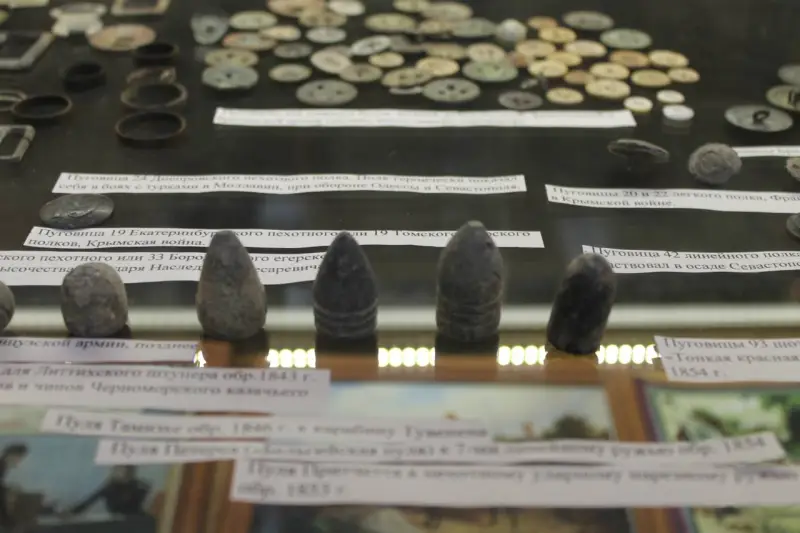
The bullets of that time, both for rifles and pistols, were simply lethal in size. Photo by the author
From end to end along the gorge Jagei, a flock of demons of dust rose,
The black flew like a young deer, but the mare rode like a chamois.
The crow bitten the mouthpiece with his teeth, the crow breathed harder,
But the mare played with a bridle like a beauty with her glove.
Here is a rock on the right and a rock on the left, thorns and piles of sand ...
And the bolt of the gun clicked three times, but nowhere he saw the shooter.
Ballad about West and East. Translation by E. Polonskaya
History rifles. Write about weapons, which I saw only in the picture, is always very difficult. But what to do if you don’t have access to real weapons, but... “you have to write,” and most importantly, you know how to do it. And this is necessary, since a great many people have not seen “pictures” (photographs) and have not held these weapons in their hands.
Even in a museum where, say, this weapon is displayed, it is under glass and inaccessible to touch. You can’t feel its weight or open the bolt of the rifle. And it also happens that... the signatures under the exhibits are made incorrectly. For example, I know a museum where in the exhibition under the Mannlicher rifle of 1895 the following inscription is made: “Berdan rifle of 1893. Made in England in 1914." How can this be? But it can! And not only that!
Therefore, whenever I manage to hold museum rarities of this or that weapon in my hands, I cannot help but rejoice, since it gives both knowledge and impressions. For example, I literally just had a chance to look at the collection of firearms at the Penza Regional Museum of Local Lore. And since we are currently running a series of articles on the history of rifles at VO, today we will talk about rifles from this collection.
In previous articles in this series, we said that the most serious problem with the “screw guns” of the early 19th century was the lack of a reliable way to ensure that the bullet would engage in the rifling. On the same “Kentucky rifles” it was solved very simply - they used a wad made of deer suede, well lubricated with lard, on which a lead bullet was placed before driving into the barrel.
And this solved the problem, but... greatly slowed down the loading process. It was desirable that the bullet be driven into the barrel, if not in the same way as with the Brown Bess musket, that is, by hitting the butt on the ground, then at least simply with a ramrod, without the use of special beaters and additional splashing.
The first innovator to do anything noticeable along this path was Henri-Gustave Delvigne (1800–1876), a French infantry captain who was discharged from service in 1830. In 1826, he proposed an improvement to the breech of rifled guns, making them easier to load, and created a rifle that received his name.
But the whole point was that the black powder that was used then quickly covered the surface of the barrel with soot. Therefore, even three or four shots were enough for a rifle loaded from the muzzle to be reloaded only with the help of a hammer, driving the bullet into the barrel by hitting the ramrod.
Delvigne came up with a chamber with a diameter smaller than the bore, to which it was connected by a spherical surface with a radius equal to the bullet used. Gunpowder, as before, was poured from the barrel into the chamber, but when the bullet was lowered into the barrel, it now rested on the rim of the chamber. When the ramrod struck a soft lead bullet, it flattened, increased in diameter, was pressed into the rifling on the barrel, and after the shot began to rotate and fly out of the barrel. At the same time, shooting accuracy was slightly increased compared to smooth-bore guns.
According to artillery historian John Gibbon:
It should be noted here that by this time experiments were being carried out everywhere to create effective bullets for both rifled and, primarily, smooth-bore weapons, the results of which are shown in the illustration below.
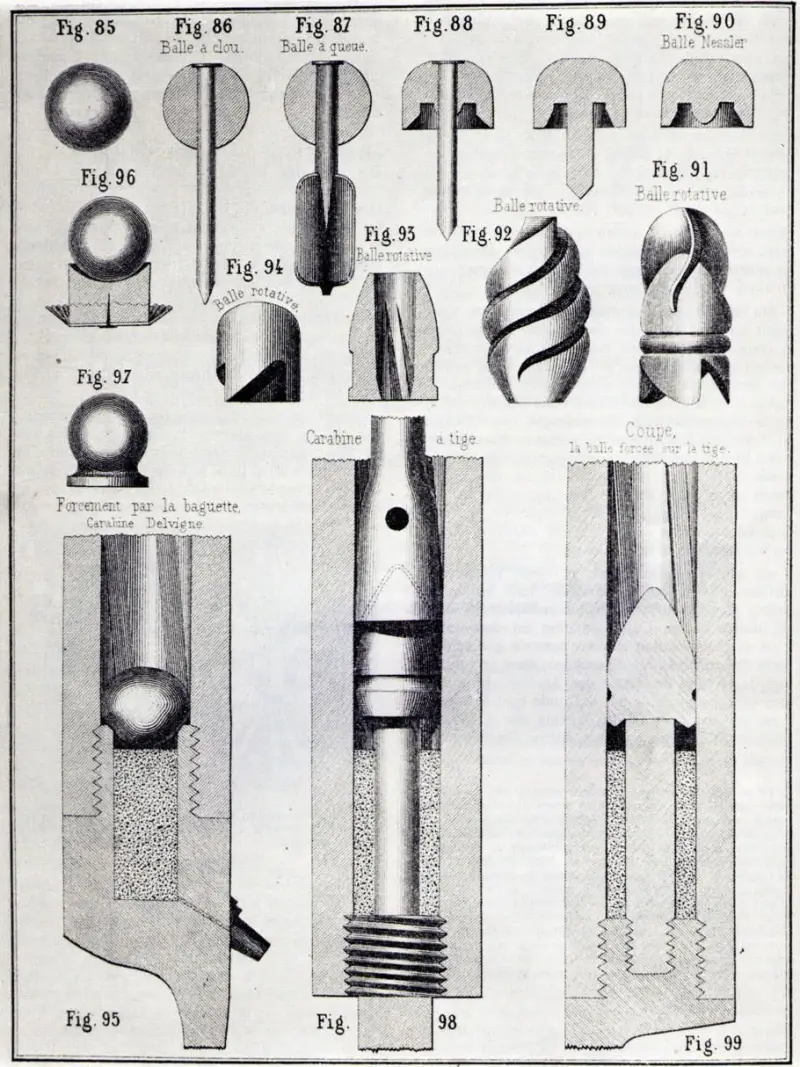
Various types of bullets for weapons of the early 85th century. F86 is a standard spherical bullet for smoothbore and rifled weapons, F87 is a bullet with a pin stabilizer made of a nail, F88 is a bullet with a nail and a stabilizer, F89, 90 are varieties of solid bullets with a pin stabilizer, F91 is a bullet of the Neusler design for smoothbore guns, F94– 96 – bullets rotating by the oncoming air flow, F97 – a bullet with Thierry’s spigot, F95 – Delvin’s bullet for his “chamber fitting”, F98 – diagram of the chamber of Delvin’s rifle, F99 – diagram of the chamber of Thuvinen’s rifle, FXNUMX – chamber and sectional view of Thuvenin’s rifle bullet
To make them fly more accurately, they tried to wrap them in fabric so that they resembled a badminton shuttlecock, and inserted a nail into them to act as a “tail.” There were bullets that had stabilizer blades at the end of the nail; finally, Neusler bullets were invented, which expanded in the bore of smoothbore guns and fit tightly to the walls, which also increased their accuracy. Bullets with spiral rifling and blades were also invented, which made them rotate in flight due to the air flowing into them.
A lot of things were invented, but most of all these bullets were too complex and therefore expensive, but they still increased shooting accuracy only slightly.
Well, Delvigne himself immediately noticed that the bullet flattened in the barrel had poor aerodynamic quality, that is, having won in one, he immediately lost in the other!
In 1840, another French officer, S. Thierry, figured out how to improve the aerodynamics of the bullet in the Delvigne rifle. He placed it on a wooden shpigel (pallet) and added an oiled wad to it. Spiegel did not allow the bullet to be pressed deeply into the chamber, and it began to deform less from the impacts of the ramrod. When fired, the bullet on the spigot ran more steadily along the rifling of the barrel bore, and the wad at the same time also cleaned the bore.
After this, the Delvin fitting was finally put into service, but it turned out to be impossible to completely avoid the wrong flight of the bullet in this case.
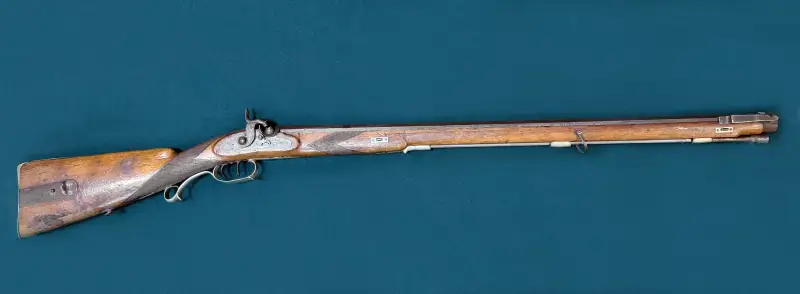
Belgian fitting 1843. Total length - 123 (without bayonet) cm. Barrel length - 83 cm. Caliber: 15,8 mm at the bottom of the rifling; 15,2 mm along the rifling fields. Penza Regional Museum of Local Lore. Author's photo
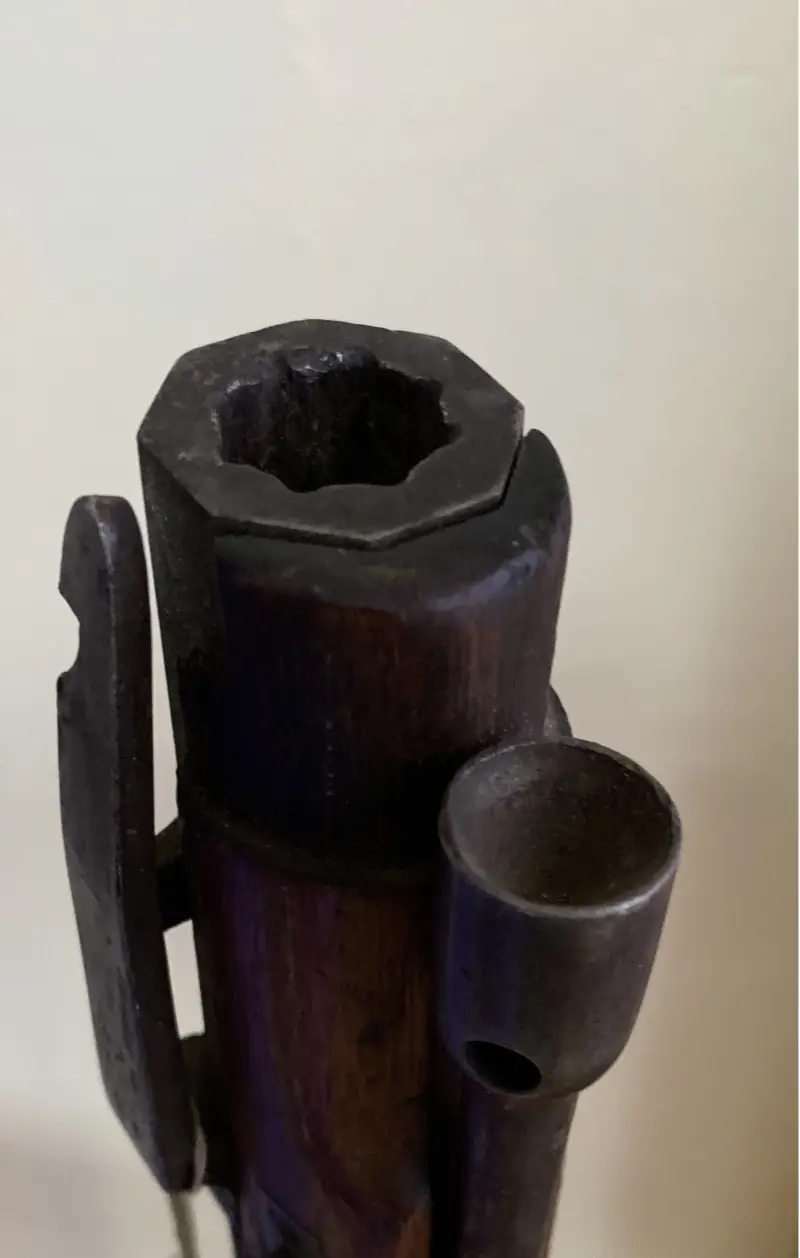
Muzzle of the 1843 fitting.
In 1841, Delvigne finally decided to abandon spherical bullets and came up with a cylindrical pointed bullet with a flat bottom, and in 1849 he developed a new version with a depression in the bottom and a protrusion in the center, which gave better expansion of the bullet by powder gases when fired. That is, Delvigne practically confirmed the good ballistic data of a pointed bullet, only a century earlier the same thing was theoretically substantiated by I. G. Leitman, a professor at the St. Petersburg Academy of Sciences!
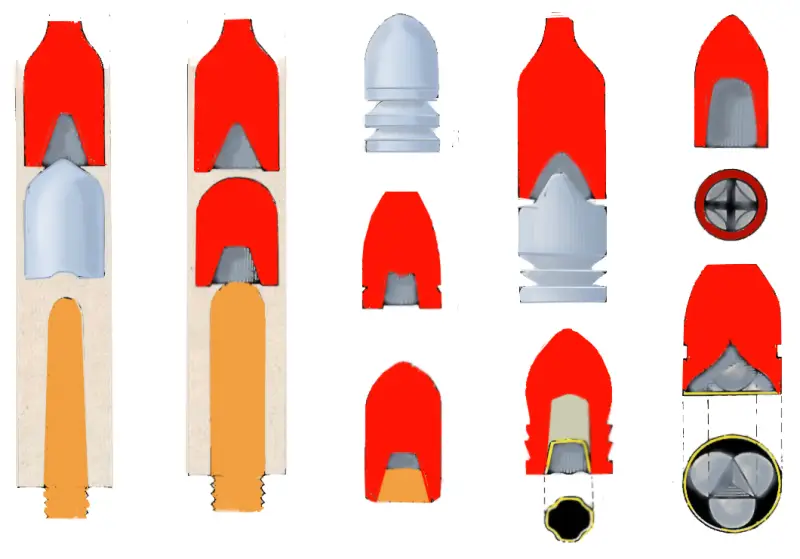
Various types of cleaning rods and bullets for rifles of the early 19th century. in the section. The third bullet in the bottom row is the English Pritchett system with a wooden plug. Following it is a Minie bullet with a metal cup. The last bullet below is a variant of the Neusler bullet. The figure gives a clear idea that each type of bullet also required its own special cleaning rod. Drawing by A. Sheps
Meanwhile, namely in 1842, another French officer, colonel of the rifle school in Vincennes Louis-Etienne de Thouvenin proposed screwing a clay rod into the breech of a gun, which would protrude above the gunpowder poured into it, and onto which a cylindrical-conical bullet with depression in the bottom part.
True, to clean the chamber around the rod, it was necessary to invent a cleaning rod with a special head. But it showed a good sighting range at a distance of up to 1 m. The fitting entered service with the French light infantry and was actively used in the Crimean War. But it showed especially good fighting qualities after 100, when it received the expansion bullet of Captain Claude Minier, with a metal cup in the bottom recess.
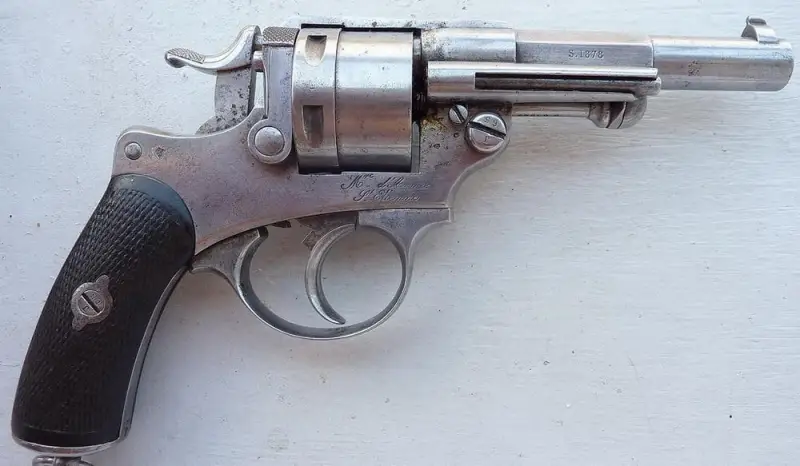
Revolver "Shamelo-Delvigne" M1873. Photo by A. Dobress
Delvigne himself later became interested in creating revolvers and, together with Joseph Chamelot, released several “Chamelot-Delvigne” revolvers, of which the best turned out to be the 1873 revolver, designated St. Etienne Mle. 1873 after the name of the city in which the factory for its production was located - Manufacture d'armes de Saint-Étienne.
But the most interesting example of rifled weapons was created not in France, but in the Duchy of Brunswick in Germany. It was designed by Major General J. Berner in 1832. In England and the USA it was called the “Brunswick fitting”, accordingly changing the name Brunswick.
The main feature of the Berner rifle was the presence in the barrel of only two wide and deep grooves, along which a spherical bullet with a transverse belt could easily be lowered into the barrel using a ramrod. The Principality of Oldenberg was the first to put the Berner gun into service with its army, then in Belgium, after which the British put it into service, introducing one important improvement into its design - a pair of semicircular cutouts appeared on the muzzle of English rifles, which helped to insert the bullet belt into the rifling by touch and This simplified loading.

“Lüttich fitting” with a bayonet. Drawing by A. Sheps
Since the length of the barrel of this gun was less than the length of infantry rifles, it was equipped with a terrifying-looking bayonet - a real “sword” like a Roman gladius, with a heavy brass hilt with a narrow cross with two symmetrical, slightly bent down ends, a little more than half a meter long. It was attached to the rifle using a long groove on the handle, into which an iron strip was inserted, soldered to the muzzle of the barrel.
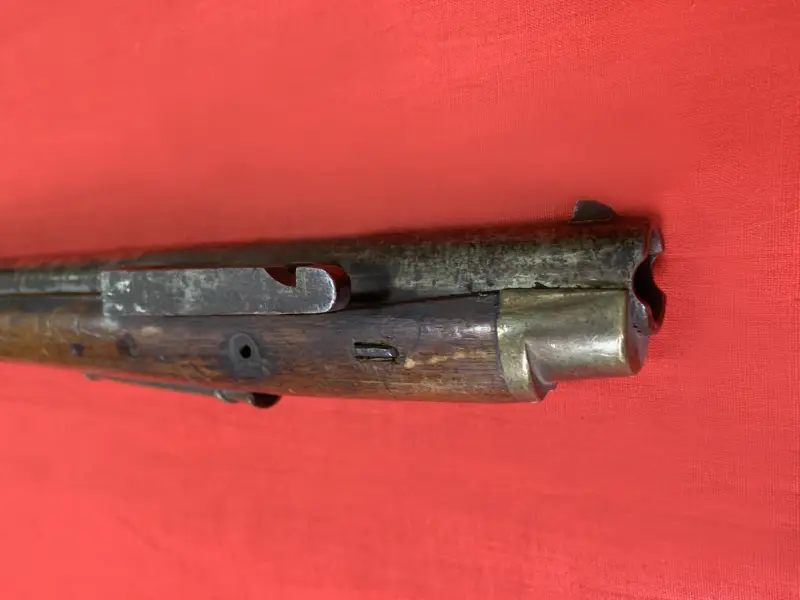
Mounting the bayonet on the barrel of the Berner fitting. Penza Regional Museum of Local Lore. Author's photo
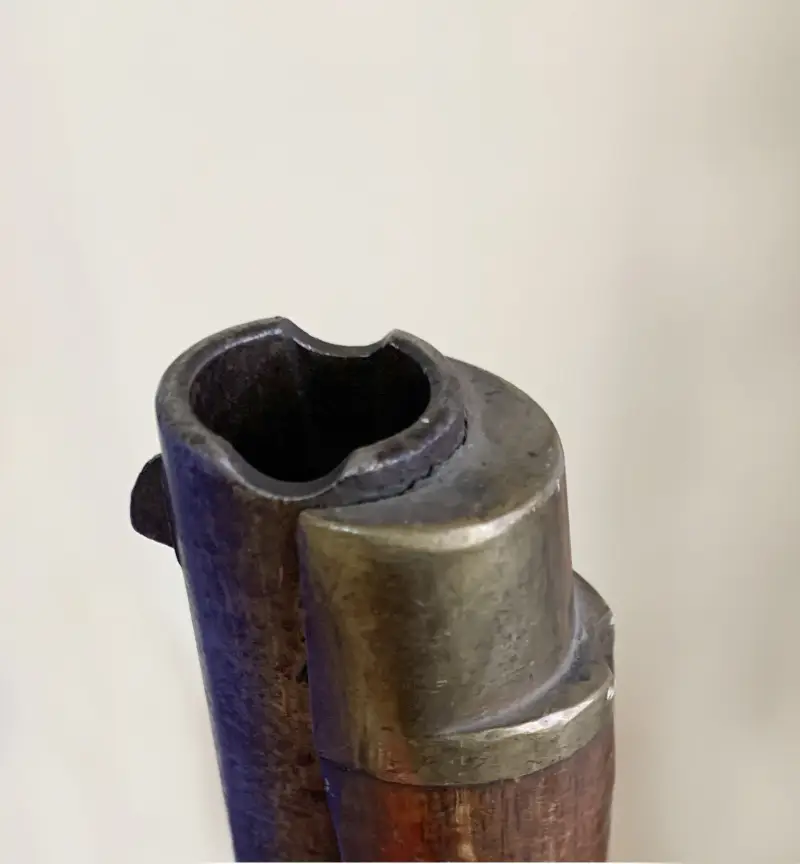
The muzzle of a Berner rifle with characteristic notches for protrusions on the bullet
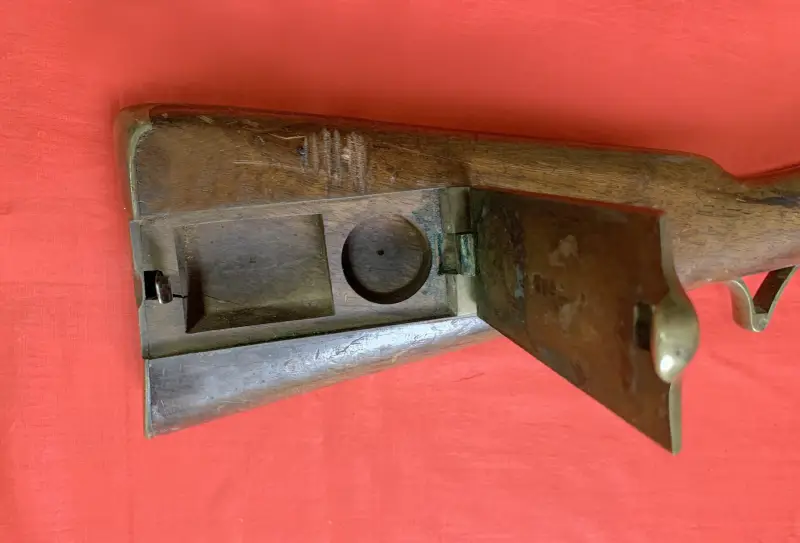
Pencil case in the butt of the Berner fitting. It has two containers - square for cartridges, round for capsules
The troops received ammunition for this type of gun “in bulk”, and the bullets were pre-wrapped in salted cotton wads, and they had to be felt through the fabric with your fingers.
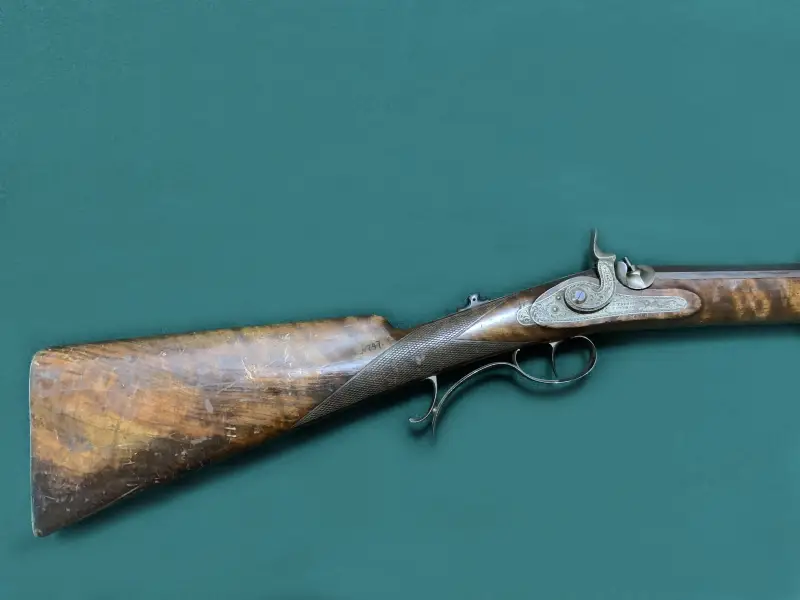
An original rifle of Anglo-Russian production from the mid-115th century. The stamp on the barrel is Guss stahl. On the keyplate are S. Petersburg and R. Tschopf. Total length – 73,4 cm. Barrel length – 10 cm. Caliber: 7 mm. Drill bit with XNUMX grooves. Also on the neck of the stock there is a mount for a diopter sight, which is absent on the rifle. The lockplate and trigger are covered with scroll carvings. The end of the trigger is broken. Penza Regional Museum of Local Lore. Author's photo
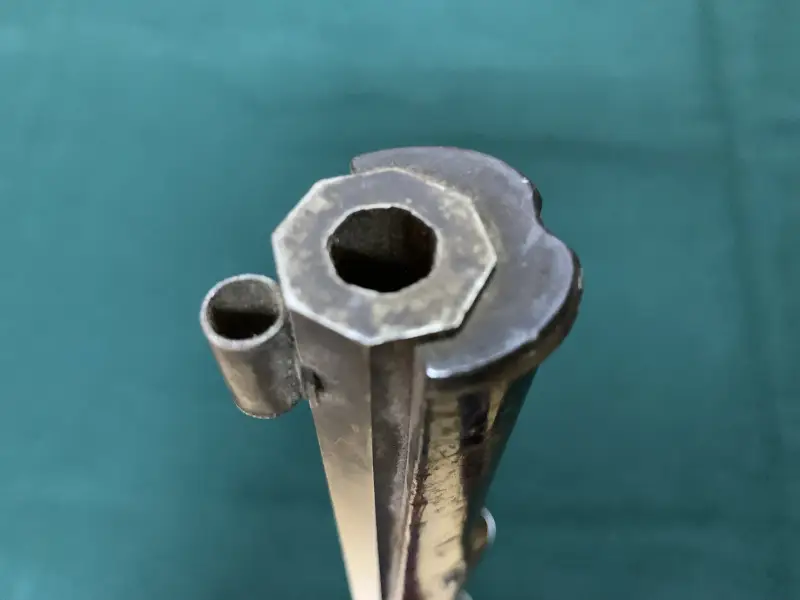
Muzzle of a rifle with 7 grooves
The Braunschweig fitting was also in service with the Russian Imperial Army, where it was called the “Lüttich fitting” after the distorted name of the Belgian city of Liege, at the factory of Louis Molerbe. It was an exact copy of the British Model 1837, with the exception of a more successful Swiss-style rear sight.
The length of the fitting without a bayonet was 124,4 cm, the caliber was 17,78 mm, the firing range of the pointed bullet with two protrusions designed by Kulikovsky, adopted in Russia, reached 1 m.
In total, there were 20 thousand such fittings in the Russian army, but the main part of them did not end up in Crimea during the Crimean War, with all the ensuing negative consequences.
Information